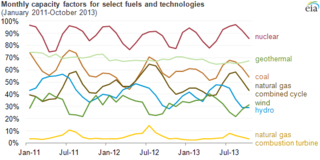
The net capacity factor is the unitless ratio of an actual electrical energy output over a given period of time to the maximum possible electrical energy output over that period. The capacity factor is defined for any electricity producing installation, such as a fuel consuming power plant or one using renewable energy, such as wind or the sun. The average capacity factor can also be defined for any class of such installations, and can be used to compare different types of electricity production.
Many nations have installed significant solar power capacity into their electrical grids to supplement or provide an alternative to conventional energy sources. Solar power plants use one of two technologies:
Guadarranque solar power plant is a photovoltaic solar power plant in the Guadarranque industrial park in San Roque, Cádiz, Spain. The plant is owned and operated by Endesa.
The Moura Photovoltaic Power Station is a large photovoltaic power station in Amareleja, in the municipality of Moura, Portugal. It is one of the largest power stations of its kind, and is built in one of the sunniest regions in Europe. Its construction involved two stages: stage 1 was completed in 2008 after 13 months, and stage 2 was completed in 2010. The entire project topped a total cost of €250 million.
Planta Solar Fuente Álamo is a photovoltaic power station in Fuente-Álamo, Murcia in Spain. It covers an area of 62 hectares. The power station has a capacity of 26 megawatts and its annual output is 44 GWh, equivalent to supply electricity to 13,000 households.
The Dulcinea Solar Plant is a photovoltaic power station in Cuenca, Spain. It consists of 300 photovoltaic generating units with a total capacity of 31.8 MW. The solar power station covers area of 230,324 m2 (2,479,186.9 sq ft). It is equipped with 82,896 Kyocera KC-200-GHT2 photovoltaic modules, 6,078 Kyocera KD-210-GHP2 modules, and 66,286 Suntech STP-210/18Ud modules. 6,600 strings of 24 photovoltaic panels linked in series 300 SMA SC100-Outdoor solar inverters. The estimated available radiation of 1,810 kWh/m2 per year is 1,497 peak sunlight hours.
The La Magascona and Magasquila photovoltaic power stations (Spanish: Planta Solar La Magascona and Spanish: Planta Solar Magasquila is a complex of photovoltaic power stations located at La Magascona, Trujillo in Cáceres, Spain. The La Magascona photovoltaic power station covers 100 hectares and it has a peak output of 23.04 MW. The power station produces approximately 46 GWh of electricity per year. It was commissioned in July 2007.
The Lucainena de las Torres Photovoltaic Power Station is a photovoltaic power station in Lucainena de las Torres, Almería in Spain. It consists of different units. Lucainena de las Torres 1 has a total capacity of 7.4 MWp and its annual output is about 11.42 GWh. It was commissioned in July 2008. Lucainena de las Torres 2 has a total capacity of 7.9 MWpand its annual output is about 12.236 GWh. It was commissioned in July 2008.
The El Coronil Solar Power Plant is a photovoltaic power station in El Coronil, Spain. The project includes different generating units. El Coronil I is a 10.08 MWp project that is equipped with 386 2X trackers, and 51,794 Yingli polycrystalline photovoltaic modules, and 24 Siemens inverters of 400 kW. The annual production capacity is 20 GWh. El Coronil II has a capacity of 10.2 MWp and it is equipped with 53,206 Yingli polycrystalline photovoltaic modules, and 24 inverters of 400 kW.

The Sevilla Photovoltaic Power Plant was the largest low-concentrated CPV power plant in the world. The facility is located in the Solar Platform, a region dedicated to solar power developments, in Sanlúcar la Mayor, Spain.
The 32 MW AC Long Island Solar Farm (LISF), located in Upton, New York, is the largest photovoltaic array in the eastern U.S. The LISF is made up of 164,312 solar panels from BP Solar which provide enough electricity for roughly 4,500 households. The project will cause the abatement of more than 30,000 metric tons of carbon dioxide emissions per year. LISF is co-owned by BP Solar and MetLife through Long Island Solar Farm LLC. Municipal utility Long Island Power Authority (LIPA) buys the 37-megawatt power plant's output, which is estimated at 44 GWh annually, under a 20-year power purchase agreement (PPA). Payments over that time are expected to total $298 million. The project was engineered by Blue Oak Energy and construction subcontracted to Hawkeye LLC from Hauppauge, New York. The plant earned the Best Photovoltaic Project of Year Award from the New York Solar Energy Industries Association. The panels are mounted at a fixed tilt angle of 35°, with the rows spaced approximately 18 ft 4 in (5.59 m) apart.
Huanghe Hydropower's Golmud Solar park is a 200 megawatt (MW) photovoltaic power station located in Golmud, Qinghai Province, China. Construction began in August 2009, and it was commissioned on October 29, 2011. 80 MW was provided by Yingli. The project won the 2012 China Quality Power Project Award. Output is expected to be 317 GWh per year.
The Lopburi Solar Farm is a 55-megawatt (MW) photovoltaic power station in Lopburi Province, Thailand. The plant was constructed over a period of 18 months beginning in 2010 with a loan of US$70 million from the Asian Development Bank, and was expected to generate 105 GWh/year. An additional 11 MW were added to the initial capacity of 73.16 MW in May 2013. Thailand used 145,300.19 GWh in 2009. The original cost estimate was US$271 million.
The Fürstenwalde Solar Park is a photovoltaic power station in Fürstenwalde, Germany. It has a capacity of 39.64 megawatt (MW) and an annual output of 36.5 GWh. The solar park was developed by the company Solarhybrid and built by conecon using 62,832 225-watt and 110,880 230-watt solar panels, both manufactured by Suntech.

Solar power in Nebraska is used for only a very small percentage of the state's electricity, although it is rapidly becoming competitive with grid electricity, due to the decrease in cost and the eight-year extension to the 30% tax credit, which can be used to install any size system. In 2015, the state ranked 47th among the 50 U.S. states with 1.1 MW of installed capacity. Solar power and wind power are easily able to provide all of Nebraska's energy need, although they would require either transmission lines to provide power when neither is available or storage. Estimates show that Nebraska could generate 3,832,600 GWh/year from wind, and 34.1% of demand from rooftop solar panels, using 8,200 MW of solar panels. Large-area solar farms would generate many times demand.
The Stillwater GeoSolar Hybrid Plant is a combined 61 MW solar energy and geothermal power plant in the U.S. state of Nevada. Located 12 miles (19 km) NE of Fallon, near Stillwater, the site includes a 26MW solar photovoltaic plant and a 2MW solar thermal plant that were added to a 33MW geothermal plant.

The Jännersdorf Solar Park is a photovoltaic power station in Prignitz, Germany. It has a capacity of 40.5 megawatts (MW) and an annual output of 38 GWh. The solar park was developed and built by Parabel AG.
Northern Chile has the highest solar incidence in the world. In October 2015 Chile's Ministry of Energy announced its "Roadmap to 2050: A Sustainable and Inclusive Strategy", which plans for 19% of the country's electricity to be from solar energy, 23% wind power and 29% hydroelectric power.
Mount Signal Solar, also known as Imperial Valley Solar Project, is a 594 MWp (460 MWAC) photovoltaic power station west of Calexico, California in the southern Imperial Valley, near the Mexican border. The facility is being developed and constructed by 8minutenergy Renewables in three phases, with two completed as of 2018. At full build-out, it will be one of the world's largest PV solar farms with a capacity of about 800 MWp (600 MWAC). The project has been supported by several environmental groups, as the power station was built on low productivity farmland.
The Springbok Solar Farm is a 328 MWp (260 MWAC) photovoltaic power station in the northwestern Mojave Desert, near California City in eastern Kern County, California. The facility is being developed and constructed by 8minutenergy Renewables in three phases, with two completed as of 2016. At full build-out, it will be one of the world's largest PV solar farms with a capacity of about 440 MWp (350 MWAC).







